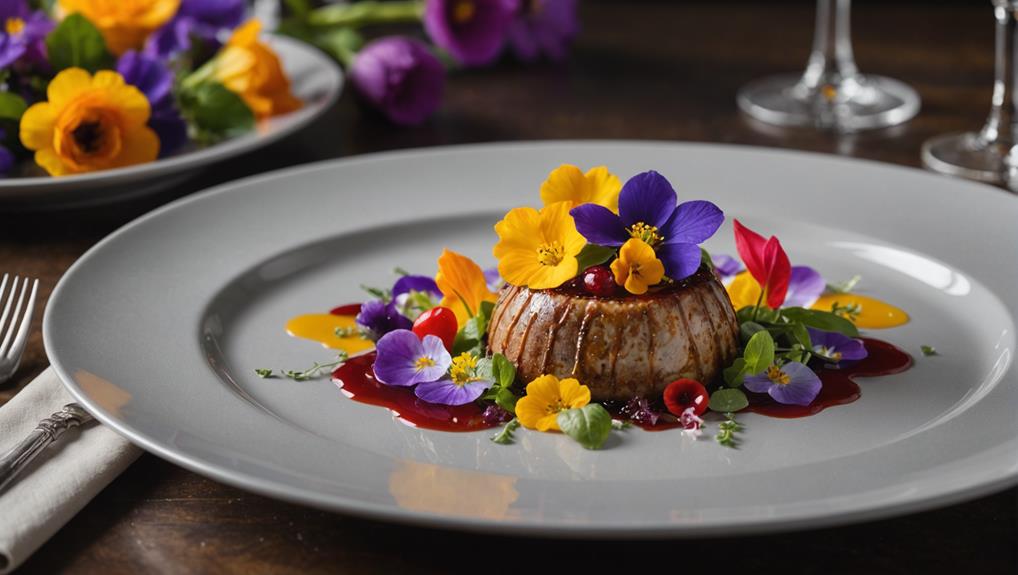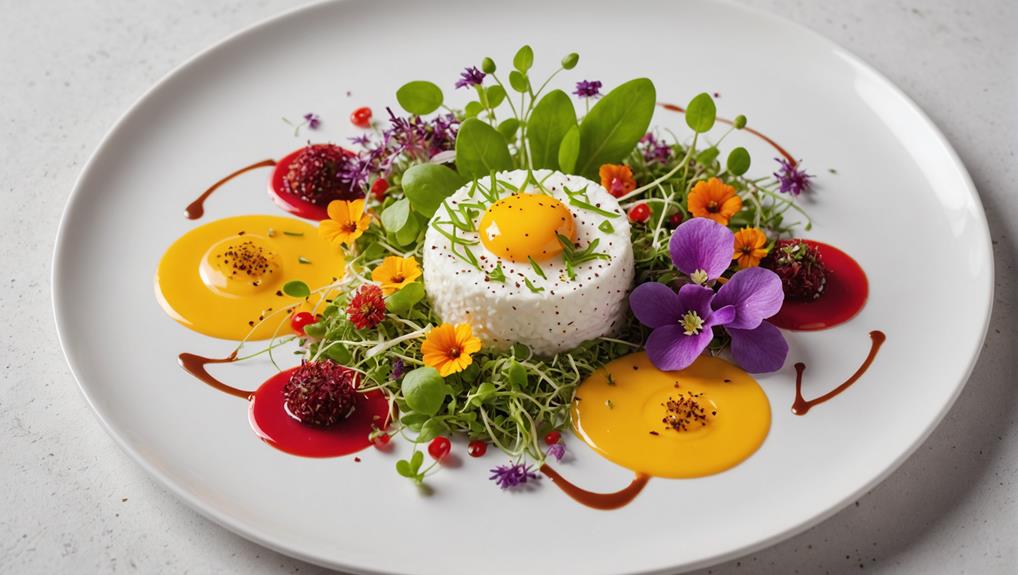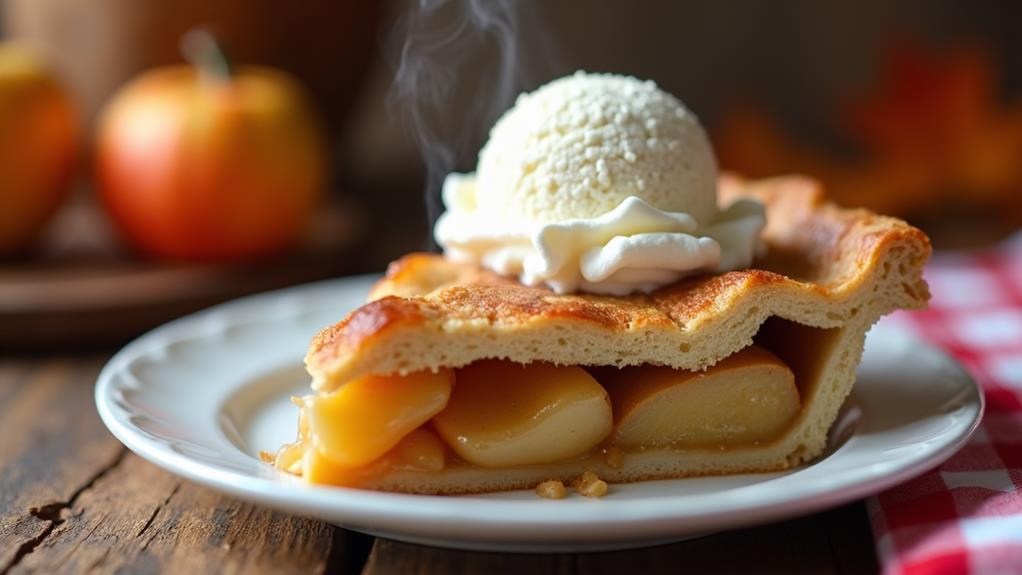Transform your culinary creations into visual masterpieces with these seven secrets of tantalizing food presentation. Start by mastering balance and composition using the classic clock face layout. Harness the power of color theory to create visually exciting plates, and layer textures for a multi-dimensional experience. Elevate your dishes with artistic garnishes and unique plating styles, utilizing negative space and asymmetrical arrangements. Enhance flavor perception through strategic color pairings and texture combinations. Finally, experiment with innovative plating techniques inspired by nature or abstract designs. By applying these principles, you'll captivate your guests' senses and take your dining experience to new heights. Discover how these techniques can revolutionize your approach to food presentation.
Create Visual Impact Through Balance
When it comes to food presentation, balance is key to creating a visually stunning dish that'll captivate diners. To elevate your plating and showcase your culinary skills, focus on achieving harmonious and cohesive arrangements. Start by distributing components evenly across the plate, ensuring no single element overpowers another. This attention to detail enhances visual appeal and the overall dining experience.
Consider using the classic clock face layout, placing carbohydrates at 11:00, vegetables at 2:00, and protein at 6:00. This technique creates a visually balanced composition that's instantly inviting. To add depth and interest, incorporate varying heights by stacking or leaning ingredients. This strategy draws the eye to key elements while maintaining balance.
Don't forget to play with textures. Combining crispy and creamy components not only enhances the dish's balance but also provides a sensory delight for your guests.
As you work on your food presentation, regularly assess the proportion and placement of elements. This ongoing refinement will help you create visually stunning dishes that align perfectly with your culinary concept.
Master Color and Contrast Techniques
To master color and contrast techniques in food presentation, you'll want to explore complementary color combinations that create visual excitement on the plate.
You can pair blue and orange elements or experiment with other striking contrasts to make your dishes pop.
Additionally, incorporating various textures alongside these color combinations will add depth and interest to your presentation, ensuring your culinary creations are as appealing to the eye as they're to the palate.
Complementary Color Combinations
Mastery of color and contrast techniques is essential for creating visually stunning dishes. When it comes to food presentation, complementary colors are your secret weapon. By utilizing the color wheel, you can select color combinations that create high contrast, making your plated dish pop with visual appeal.
For instance, a Grilled Peach and Burrata Salad showcases vibrant peaches alongside creamy burrata, exemplifying how color can enhance your dish's overall appeal. Think blue and orange, or red and green – these pairings will instantly elevate your culinary creations.
Don't stop at complementary colors, though. Experiment with analogous colors for a harmonious look that exudes calm and cohesion. Alternatively, try a monochromatic scheme to add elegance and sophistication to your presentation.
These varied approaches allow you to express your creativity and develop a signature style.
Textures for Visual Interest
Beyond the realm of color, textures play a crucial role in creating visually captivating dishes. To elevate your cooking and engage the diner's senses, incorporate a variety of textures that tantalize both the eye and palate, just like the creamy sauce in Butternut Squash Mac and Cheese which balances smoothness with the crunch of topping options.
Aim for 3-5 different textures per plate, combining creamy, crunchy, and tender elements to create a multi-dimensional culinary experience. Juxtapose contrasting textures to make your food look more inviting and create delicious flavor combinations.
Try pairing smooth sauces with crispy garnishes or tender vegetables with crunchy nuts. This interplay of textures not only enhances visual appeal but also invites exploration with each bite. Layer textures thoughtfully, such as adding a crispy element atop a creamy base, to ensure a well-rounded dish that's visually striking and satisfying to eat.
When considering textures for visual interest, don't forget to utilize the color wheel. Selecting complementary colors allows you to incorporate diverse textures that contrast with one another, further enhancing the overall presentation.
Layer Textures for Sensory Delight
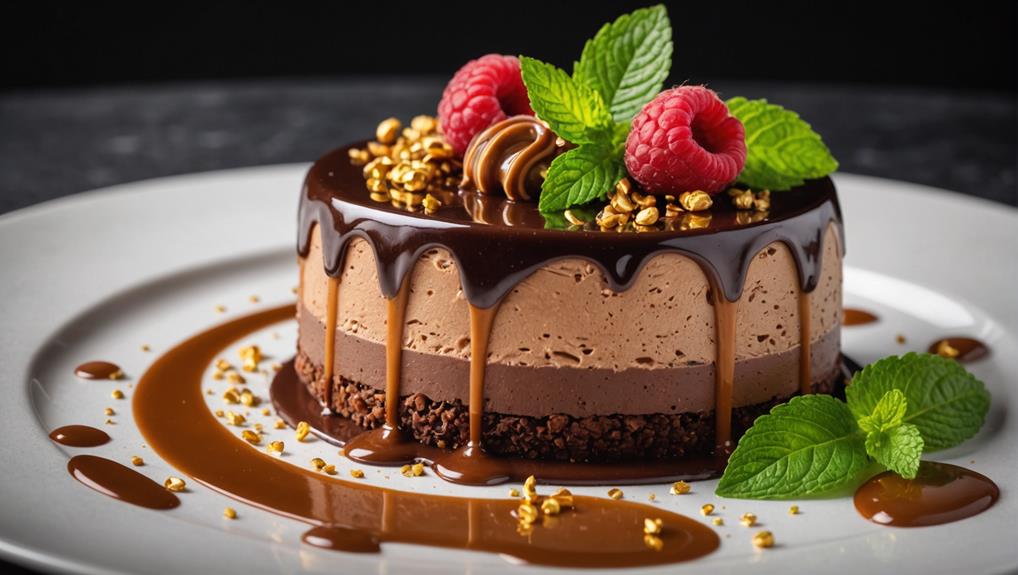
A symphony of textures on your plate can transform an ordinary meal into an extraordinary culinary experience. To layer textures for sensory delight, incorporate 3-5 distinct elements in your dish.
For example, consider adding a refreshing Cucumber Mint Salad as a side, which features crisp cucumbers and vibrant mint, providing a bright contrast to heavier dishes. Combine creamy sauces, crunchy toppings, and tender proteins to create a harmonious interplay of flavors and mouthfeel.
This variety of textures not only makes your creation visually appealing but also keeps diners engaged with every bite.
To elevate your culinary scene, carefully stack components or use techniques like frying, roasting, and pureeing. The contrast between smooth and crunchy elements adds excitement as diners explore their plates.
You'll enhance flavor perception by pairing a crisp garnish with a rich, creamy base, providing a satisfying crunch that heightens the overall experience.
Elevate Dishes With Artistic Garnishes
Vibrant edible flowers and delicate microgreens can transform a simple dish into a captivating work of art. When you're aiming to elevate your culinary creations, artistic garnishes are your secret weapon. They not only enhance visual appeal but also introduce complementary flavors that tantalize the taste buds.
To master thoughtful garnishing, consider the balance between aesthetics and taste. High-quality oils or sauces can provide an elegant finish, but ensure they harmonize with the dish rather than overpower it.
Incorporate a variety of textures to create a multi-dimensional dining experience. Crispy fried shallots or smooth avocado purée can add depth and interest to your presentation.
Remember, intentional placement is key. Use negative space effectively to draw attention to the main components, and experiment with asymmetrical arrangements for a sense of abundance.
As you refine your garnishing techniques, you'll discover endless possibilities for turning each plate into a unique masterpiece. By embracing this creative aspect of food presentation, you'll encourage diners to engage with their meals on a whole new level, making every bite an unforgettable experience.
Compose Elegant Plating Arrangements

Mastering elegant plating arrangements can truly set your dishes apart. To plate like a pro, utilize the classic clock face layout, positioning carbohydrates at 11:00, vegetables at 2:00, and protein at 6:00. This approach ensures a balanced and visually pleasing composition.
In the art of plating, incorporating height is crucial. Stack or lean components to add visual drama and excitement to your dish.
Experiment with contrasting colors and textures to create a striking effect. Dark plates can make light food items pop, enhancing their visibility. Embrace asymmetry and odd-numbered arrangements to convey abundance and visual interest.
Draw inspiration from nature by considering the flow and movement of ingredients. Use long lines of vegetables and artistic sauce drizzles to achieve a dynamic presentation.
In the culinary world, creating visually stunning plates is an essential skill. By applying these techniques, you'll transform your kitchen into a studio for edible art.
Enhance Flavors Through Presentation
To enhance flavors through presentation, you'll want to focus on complementary color pairings and texture layering techniques.
By strategically combining colors that contrast or complement each other, you can create visually striking dishes that stimulate the appetite and heighten the perception of taste.
Incorporating various textures, such as crispy elements alongside smooth components, adds depth to your plating and creates a multi-dimensional eating experience that engages all the senses.
Complementary Color Pairings
The palette on your plate isn't just about taste—it's a visual feast that can enhance your dining experience. Complementary color pairings are the secret weapon of innovative chefs and food enthusiasts alike. By strategically using high-contrast combinations like blue and orange or red and green, you'll create a harmonious plate that not only looks stunning but also stimulates appetite and interest.
To elevate your culinary creations, incorporate a variety of colors that showcase different flavors and textures. Imagine the visual interest of bright yellow squash nestled against deep purple eggplant—it's a feast for the eyes that promises a delightful taste adventure.
Don't forget the power of fresh herbs and edible flowers to add pops of color, aroma, and flavor. Research shows that diners perceive dishes with vibrant hues as more flavorful and appealing, so let the color wheel be your guide.
Texture Layering Techniques
Texture layering is the chef's secret weapon for creating unforgettable dishes. By incorporating 3-5 distinct textures in a single plate, you'll elevate your culinary creations from ordinary to extraordinary. This technique isn't just about taste; it's a multisensory experience that engages diners throughout their meal.
To master texture layering techniques, start by combining creamy, crunchy, and tender elements. This contrast creates a dynamic tasting experience, allowing different flavors to unfold with each bite. Your cooking style plays a crucial role here. Use frying for crispy crusts and gentle methods to preserve vibrant colors in vegetables.
Carefully placed textures, like a crunchy topping on a smooth purée, add visual appeal and encourage interactive exploration. Balance is key when layering textures. Pair rich, savory components with lighter, crisp textures to create a harmonious and memorable dining experience.
Inspire With Unique Plating Styles
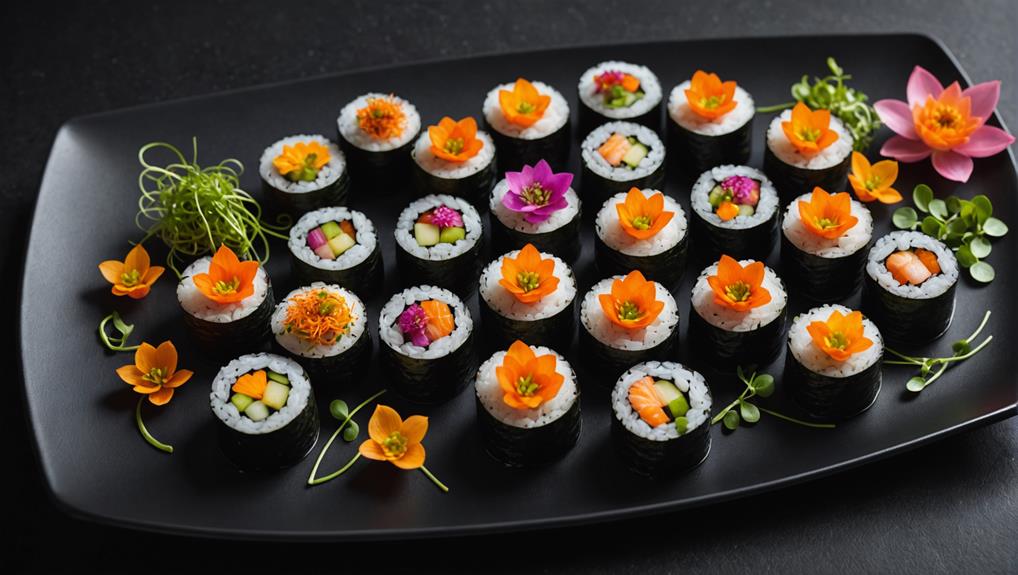
Culinary artists can elevate their dishes from mere sustenance to visual masterpieces through unique plating styles. By embracing innovative plating techniques, you'll evoke emotion and transform your kitchen into a gallery of edible art. The right presentation can blend ingredients seamlessly, creating a stunning color palette that enhances the dining experience.
Consider these avant-garde approaches to inspire your plating:
- Abstract designs inspired by sculptures or paintings
- Nature-inspired layouts mimicking landscape gardens
- Minimalist styles emphasizing simplicity and negative space
- Avant-garde techniques pushing traditional boundaries
Experiment with abstract plating by arranging food in artistic patterns, allowing for personal expression.
Utilize nature-inspired designs by incorporating long lines of vegetables and artistic sauce drizzles, creating a dynamic visual flow.
For a more refined look, try minimalist plating that emphasizes clean lines and draws attention to key ingredients.
Don't forget the classic clock face layout for traditional dishes, ensuring balanced proportions of carbs, veggies, and proteins.
Frequently Asked Questions
What Are the 7 Guidelines in Plating?
Create visual intrigue with color contrast and height variation. Balance textures and place sauces strategically. Master garnish techniques and control portions. Choose plates wisely and maintain theme consistency. Incorporate seasonal ingredients for innovative, eye-catching presentations that'll wow your guests.
How Do You Make a Food Presentation Interesting?
Paint a feast for the eyes! You'll captivate diners by playing with color contrasts, texture variety, and height variation. Master garnish placement and sauce techniques, while balancing portion sizes. Embrace seasonal ingredients, coordinate themes, and wield innovative plating tools.
What Are the 3 Most Important Things to Remember When Plating Food for Presentation?
When plating food, focus on these three key elements: color contrast to captivate the eye, texture balance for sensory delight, and portion control for harmonious composition. Don't forget height variation, sauce artistry, and strategic garnish placement to elevate your presentation.
What Are the Best Plates for Food Presentation?
You'll dazzle with ceramic textures and vibrant colors. Choose plate shapes that elevate your cuisine. Embrace rustic finishes or minimalist designs, contrasting heights for depth. Explore themed collections, functional aesthetics, and seasonal themes to innovate your presentation game.
Final Thoughts
By mastering these seven secrets of tantalizing food presentation, you'll transform your dishes into visual masterpieces that captivate your guests. Consider the case of Chef Maria, who elevated her restaurant's ratings by focusing on artistic plating. Her signature dish, a deconstructed lemon tart, became an Instagram sensation due to its stunning presentation. Remember, we eat with our eyes first, so don't underestimate the power of a well-presented meal. With practice and creativity, you'll soon be plating like a pro.

